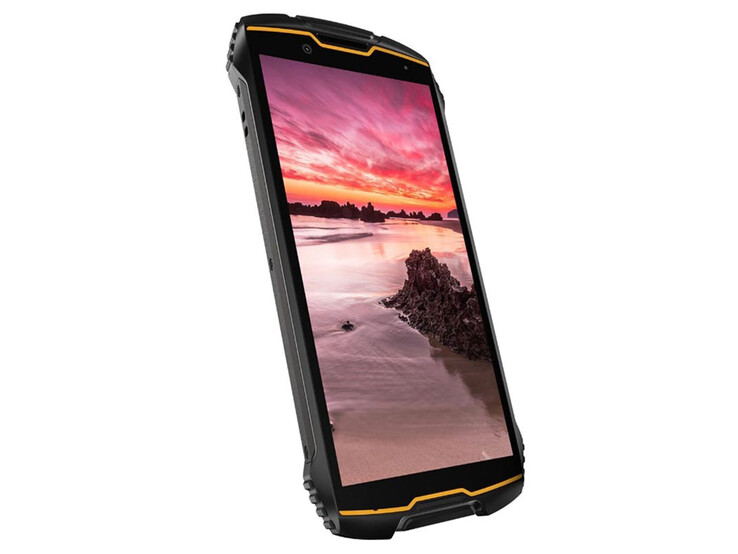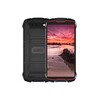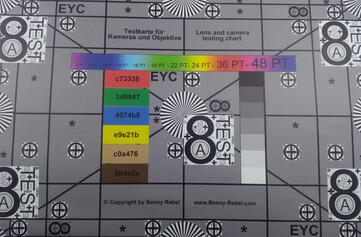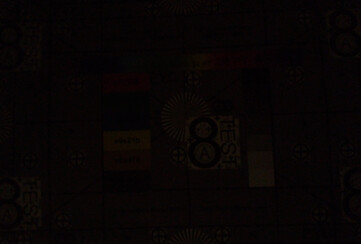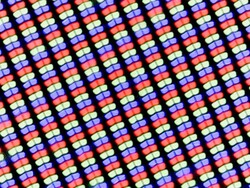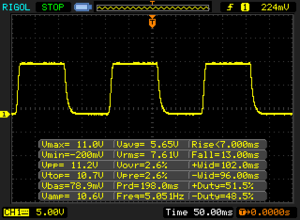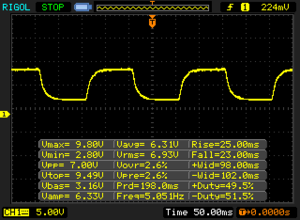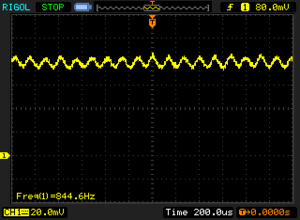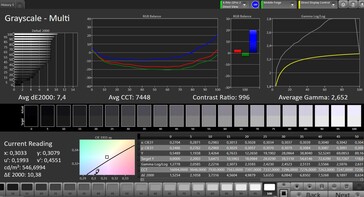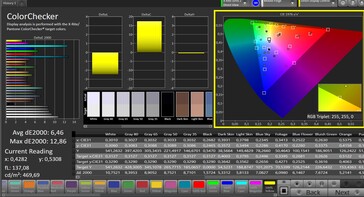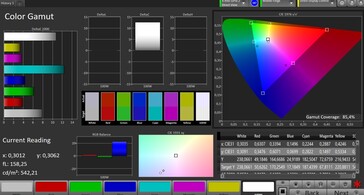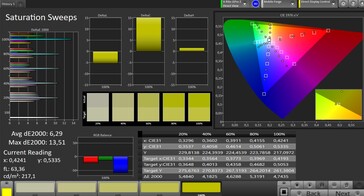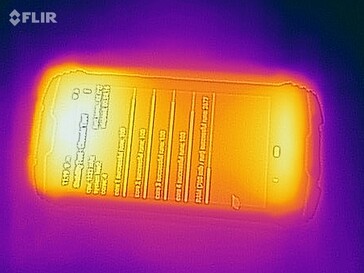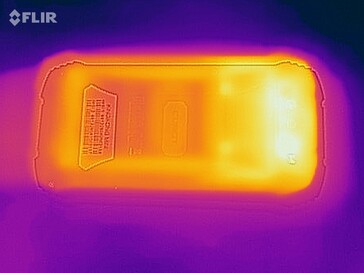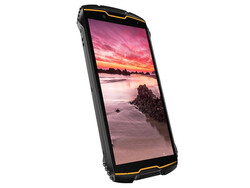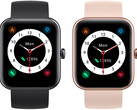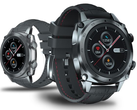Cubot KingKong Mini Smartphone Review – Handy Mobile Phone from China
Comparison devices
Bewertung | Rating Version | Datum | Modell | Gewicht | Laufwerk | Groesse | Aufloesung | Preis ab |
|---|---|---|---|---|---|---|---|---|
| 73.5 % v7 (old) | v7 (old) | 02 / 2020 | Cubot Kingkong Mini Helio A22 MT6761, PowerVR GE8300 | 124 g | 32 GB eMMC Flash | 4.00" | 1080x540 | |
| 89.3 % v6 (old) | v6 (old) | 12 / 2017 | Sony Xperia XZ1 Compact SD 835, Adreno 540 | 143 g | 32 GB UFS 2.0 Flash | 4.60" | 1280x720 | |
| 79.6 % v7 (old) | v7 (old) | 04 / 2016 | Apple iPhone SE A9, A9 / PowerVR GT7600 | 113 g | 64 GB eMMC Flash | 4.00" | 1136x640 | |
| 79 % v6 (old) | v6 (old) | 01 / 2018 | CAT S31 210 MSM8909, Adreno 304 | 200 g | 16 GB eMMC Flash | 4.70" | 1280x720 | |
| 75.7 % v7 (old) | v7 (old) | 04 / 2019 | Cubot King Kong 3 Helio P23 MT6763T, Mali-G71 MP2 | 280 g | 64 GB eMMC Flash | 5.50" | 1440x720 |
Case, equipment and operation - Small and stable
The Cubot KingKong Mini is a small 4-inch mobile phone with the typical look of an outdoor smartphone: A rubber-like plastic surface, metal side panels and visible screws are intended to visually emphasize the stability of the phone. The case is robustly built overall and, according to the manufacturer, is also protected against dust and water. However, there is no official IP certification for this and Cubot explicitly excludes water damage as a reason for warranty. In this case, one is probably dependent on the goodwill of the dealer from whom one bought the smartphone.
You can get the Smartphone for just under 110 Euros, 32 GB mass storage and 3 GB RAM are quite a decent equipment. To access the dual SIM slots and the dedicated microSD slot, you have to use the included screwdriver and unscrew a part of the back. In terms of WLAN, the KingKong Mini does quite well in our test with the reference router Linksys Nighthawk AX12. For example, it offers significantly faster transfer rates than the Cubot King Kong 3.
As the smartphone is very handy, it is easy to use for people with small hands and children, but people with larger hands have to live with the rather small buttons. Overall, the Smartphone fits well in the hand and the touchscreen is quite accurate. There is no fingerprint sensor.
| Networking | |
| iperf3 transmit AX12 | |
| Sony Xperia XZ1 Compact | |
| Cubot Kingkong Mini | |
| Cubot King Kong 3 | |
| CAT S31 | |
| iperf3 receive AX12 | |
| Sony Xperia XZ1 Compact | |
| Cubot Kingkong Mini | |
| Cubot King Kong 3 | |
| CAT S31 | |
Cameras - At the level of the price range
A dual camera is available at the back, whereby the second lens only serves to calculate depth of field and cannot be used as a separate lens. The main lens has a resolution of 13 megapixels and makes a passable impression in our test shots for the reasonable price of the Cubot KingKong Mini: although surfaces quickly appear pixelated and there are blurred areas, under normal lighting conditions the camera can be used for snapshots. In low light, however, the camera's performance is not very convincing with little dynamic range and sharpness. At 1 lux illuminance, nothing is visible in the pictures.
Videos can be recorded in 1080p, the quality here is also okay in normal light, but transitions of different light levels are made with visible gradations and on closer inspection many details appear blurred.
The front camera has a decent high resolution of 8 megapixels. The pictures don't seem incredibly sharp, but for the price point of the Cubot phone they are okay.
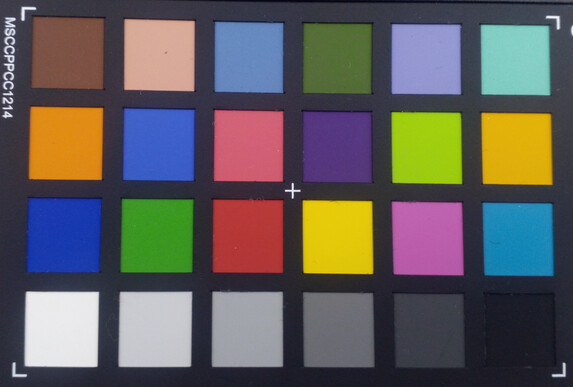
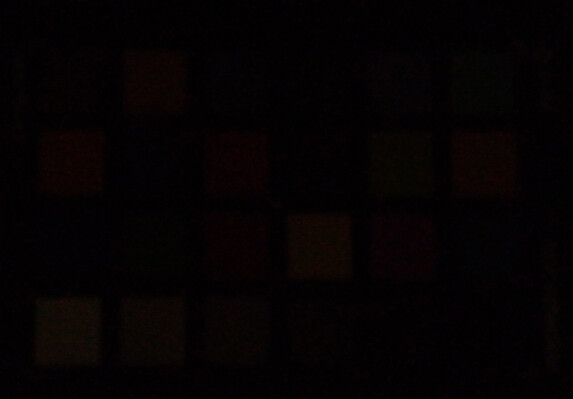
Display - Bright, but not very true color
The Cubot King Kong Mini comes with a 4-inch display with IPS technology that averages 545 cd/m² in brightness. However, the illumination is not very even. The Helligketi on sight is quite good for the price range and beats other outdoor smartphones from Cubot.
The resolution of 1,080 x 540 pixels is unusual and not particularly high, but as the screen is quite small, this is not so noticeable in everyday life. We measured PWM at a fairly high frequency of around 845 Hz, so there should normally be no problems with this.
The contrast ratio of 1.028:1 could be better, dark areas show a clear grey haze. Colours and greyscales also partly deviate quite clearly from the reference value, so you shouldn't evaluate printing colours on the screen. A hefty blue cast is visible.
| |||||||||||||||||||||||||
Brightness Distribution: 84 %
Center on Battery: 545 cd/m²
Contrast: 1028:1 (Black: 0.53 cd/m²)
ΔE ColorChecker Calman: 6.46 | ∀{0.5-29.43 Ø4.77}
ΔE Greyscale Calman: 7.4 | ∀{0.09-98 Ø5}
85.4% sRGB (Calman 2D)
Gamma: 2.652
CCT: 7448 K
| Cubot Kingkong Mini IPS, 1080x540, 4" | Sony Xperia XZ1 Compact IPS, 1280x720, 4.6" | Apple iPhone SE IPS, 1136x640, 4" | CAT S31 IPS, 1280x720, 4.7" | Cubot King Kong 3 IPS, 1440x720, 5.5" | |
|---|---|---|---|---|---|
| Display | |||||
| Display P3 Coverage (%) | 65.9 | ||||
| sRGB Coverage (%) | 96.8 | ||||
| AdobeRGB 1998 Coverage (%) | 68.1 | ||||
| Response Times | -74% | 13% | -5% | -16% | |
| Response Time Grey 50% / Grey 80% * (ms) | 48 ? | 56 ? -17% | 31 ? 35% | 42 ? 12% | 44 ? 8% |
| Response Time Black / White * (ms) | 20 ? | 46 ? -130% | 22 ? -10% | 24.4 ? -22% | 28 ? -40% |
| PWM Frequency (Hz) | 845 ? | 2358 ? | |||
| Screen | 12% | 18% | 33% | 9% | |
| Brightness middle (cd/m²) | 545 | 566 4% | 603 11% | 784 44% | 365 -33% |
| Brightness (cd/m²) | 545 | 560 3% | 579 6% | 750 38% | 379 -30% |
| Brightness Distribution (%) | 84 | 98 17% | 93 11% | 92 10% | 82 -2% |
| Black Level * (cd/m²) | 0.53 | 0.53 -0% | 0.88 -66% | 0.45 15% | 0.14 74% |
| Contrast (:1) | 1028 | 1068 4% | 685 -33% | 1742 69% | 2607 154% |
| Colorchecker dE 2000 * | 6.46 | 4.6 29% | 1.8 72% | 4.28 34% | 8.03 -24% |
| Colorchecker dE 2000 max. * | 12.86 | 9.4 27% | 3.5 73% | 8.75 32% | 16.34 -27% |
| Greyscale dE 2000 * | 7.4 | 6.5 12% | 2.3 69% | 6.1 18% | 10.3 -39% |
| Gamma | 2.652 83% | 2.14 103% | 2.21 100% | 2.49 88% | 2.197 100% |
| CCT | 7448 87% | 8189 79% | 6955 93% | 7175 91% | 9941 65% |
| Color Space (Percent of AdobeRGB 1998) (%) | 62.13 | ||||
| Color Space (Percent of sRGB) (%) | 96.74 | ||||
| Total Average (Program / Settings) | -31% /
-5% | 16% /
17% | 14% /
25% | -4% /
4% |
* ... smaller is better
Display Response Times
| ↔ Response Time Black to White | ||
|---|---|---|
| 20 ms ... rise ↗ and fall ↘ combined | ↗ 7 ms rise | |
| ↘ 13 ms fall | ||
| The screen shows good response rates in our tests, but may be too slow for competitive gamers. In comparison, all tested devices range from 0.1 (minimum) to 240 (maximum) ms. » 42 % of all devices are better. This means that the measured response time is similar to the average of all tested devices (20.2 ms). | ||
| ↔ Response Time 50% Grey to 80% Grey | ||
| 48 ms ... rise ↗ and fall ↘ combined | ↗ 25 ms rise | |
| ↘ 23 ms fall | ||
| The screen shows slow response rates in our tests and will be unsatisfactory for gamers. In comparison, all tested devices range from 0.165 (minimum) to 636 (maximum) ms. » 82 % of all devices are better. This means that the measured response time is worse than the average of all tested devices (31.6 ms). | ||
Screen Flickering / PWM (Pulse-Width Modulation)
| Screen flickering / PWM detected | 845 Hz | ||
| ≤ 15 cd/m² brightness | |||
The display backlight flickers at 845 Hz (worst case, e.g., utilizing PWM) Flickering detected at a brightness setting of 15 cd/m² and below. There should be no flickering or PWM above this brightness setting. The frequency of 845 Hz is quite high, so most users sensitive to PWM should not notice any flickering. As the flickering occurs only on very low brightness settings, it should not be an issue in typical office settings. Nonetheless, use in low light conditions may be straining to the eyes. In comparison: 53 % of all tested devices do not use PWM to dim the display. If PWM was detected, an average of 8081 (minimum: 5 - maximum: 343500) Hz was measured. | |||
Performance, emissions and battery life - Long lasting
The processor is quite conductive for this price range: The MediaTek Helio A22 ensures mostly smooth navigation through the menus and also offers a few power reserves. However, this only applies to the processor part; the graphics card can't keep up with most other smartphones. However, the low resolution of the screen helps here again, so that some somewhat more demanding games are still playable after all.
In terms of memory performance, the Cubot KingKong Mini is once again quite brave and the microSD Toshiba Exeria Pro M501 is also read quite fast.
However, the small case is obviously difficult to cool, with a maximum of 45.6°C it can warm up noticeably and can also become unpleasant in summer if you put it under load for a longer time. A warming is also noticeable in idle mode, but this is less serious.
The mono loudspeaker is mounted on the back, which isn't ideal because you can easily cover it with your hand or a smartphone lying on the table only sounds muffled. In return, the speaker also becomes quite loud. The sound is very, very high frequency and sounds unpleasant in the ears at high volumes. Overall, the speaker cannot be recommended for listening to music for a longer period of time.
The battery is short with 2.000 mAh and can't be replaced. Due to the small screen, it's still enough for a runtime of up to 16:37 hours in our WLAN test, which proves to be extremely suitable for everyday use. Thus, even two days in the office shouldn't be a problem, even with demanding use, without charging the smartphone.
| PCMark for Android | |
| Work performance score (sort by value) | |
| Cubot Kingkong Mini | |
| Sony Xperia XZ1 Compact | |
| CAT S31 | |
| Cubot King Kong 3 | |
| Average Mediatek Helio A22 MT6761 (4229 - 7216, n=9) | |
| Work 2.0 performance score (sort by value) | |
| Cubot Kingkong Mini | |
| Sony Xperia XZ1 Compact | |
| CAT S31 | |
| Cubot King Kong 3 | |
| Average Mediatek Helio A22 MT6761 (4195 - 5511, n=11) | |
| GFXBench | |
| on screen Aztec Ruins Normal Tier Onscreen (sort by value) | |
| Cubot Kingkong Mini | |
| Cubot King Kong 3 | |
| Average Mediatek Helio A22 MT6761 (2.3 - 6.1, n=14) | |
| Average of class Smartphone (6.2 - 166, n=208, last 2 years) | |
| 1920x1080 Aztec Ruins Normal Tier Offscreen (sort by value) | |
| Cubot Kingkong Mini | |
| Cubot King Kong 3 | |
| Average Mediatek Helio A22 MT6761 (1.9 - 4.2, n=14) | |
| Average of class Smartphone (3.4 - 367, n=208, last 2 years) | |
| on screen Aztec Ruins High Tier Onscreen (sort by value) | |
| Cubot Kingkong Mini | |
| Cubot King Kong 3 | |
| Average Mediatek Helio A22 MT6761 (2.7 - 3.9, n=14) | |
| Average of class Smartphone (0.85 - 144, n=209, last 2 years) | |
| 2560x1440 Aztec Ruins High Tier Offscreen (sort by value) | |
| Cubot Kingkong Mini | |
| Cubot King Kong 3 | |
| Average Mediatek Helio A22 MT6761 (0.7 - 0.9, n=14) | |
| Average of class Smartphone (1.2 - 146, n=208, last 2 years) | |
| Cubot Kingkong Mini | Sony Xperia XZ1 Compact | CAT S31 | Cubot King Kong 3 | Average 32 GB eMMC Flash | Average of class Smartphone | |
|---|---|---|---|---|---|---|
| AndroBench 3-5 | 76% | -31% | -8% | 7% | 1268% | |
| Sequential Read 256KB (MB/s) | 246.9 | 668 171% | 71.1 -71% | 241 -2% | 242 ? -2% | 2235 ? 805% |
| Sequential Write 256KB (MB/s) | 129.7 | 119.9 -8% | 62.1 -52% | 134.3 4% | 100.5 ? -23% | 1871 ? 1343% |
| Random Read 4KB (MB/s) | 26.9 | 113.3 321% | 14.28 -47% | 17.21 -36% | 43.1 ? 60% | 297 ? 1004% |
| Random Write 4KB (MB/s) | 17 | 17.13 1% | 14.81 -13% | 11.21 -34% | 22.3 ? 31% | 343 ? 1918% |
| Sequential Read 256KB SDCard (MB/s) | 83.5 ? | 73.3 ? -12% | 81.8 -2% | 81.2 -3% | 71.8 ? -14% | |
| Sequential Write 256KB SDCard (MB/s) | 60.2 ? | 50.2 ? -17% | 59.5 -1% | 74.3 23% | 52.9 ? -12% |
Temperature
(-) The maximum temperature on the upper side is 45.6 °C / 114 F, compared to the average of 35.2 °C / 95 F, ranging from 21.9 to 247 °C for the class Smartphone.
(-) The bottom heats up to a maximum of 45.6 °C / 114 F, compared to the average of 34 °C / 93 F
(±) In idle usage, the average temperature for the upper side is 36.1 °C / 97 F, compared to the device average of 32.9 °C / 91 F.
Speakers
Cubot Kingkong Mini audio analysis
(+) | speakers can play relatively loud (86.7 dB)
Bass 100 - 315 Hz
(-) | nearly no bass - on average 28.8% lower than median
(±) | linearity of bass is average (8.1% delta to prev. frequency)
Mids 400 - 2000 Hz
(±) | higher mids - on average 10.6% higher than median
(±) | linearity of mids is average (12.8% delta to prev. frequency)
Highs 2 - 16 kHz
(±) | higher highs - on average 14.5% higher than median
(±) | linearity of highs is average (8.2% delta to prev. frequency)
Overall 100 - 16.000 Hz
(-) | overall sound is not linear (41.6% difference to median)
Compared to same class
» 86% of all tested devices in this class were better, 0% similar, 13% worse
» The best had a delta of 11%, average was 35%, worst was 134%
Compared to all devices tested
» 95% of all tested devices were better, 0% similar, 5% worse
» The best had a delta of 4%, average was 24%, worst was 134%
Cubot King Kong 3 audio analysis
(±) | speaker loudness is average but good (81.9 dB)
Bass 100 - 315 Hz
(-) | nearly no bass - on average 64.5% lower than median
(+) | bass is linear (0% delta to prev. frequency)
Mids 400 - 2000 Hz
(-) | nearly no mids - on average 64.5% lower than median
(+) | mids are linear (0% delta to prev. frequency)
Highs 2 - 16 kHz
(-) | nearly no highs - on average 64.5% lower than median
(+) | highs are linear (0% delta to prev. frequency)
Overall 100 - 16.000 Hz
(-) | overall sound is not linear (121.4% difference to median)
Compared to same class
» 90% of all tested devices in this class were better, 8% similar, 2% worse
» The best had a delta of 11%, average was 35%, worst was 134%
Compared to all devices tested
» 97% of all tested devices were better, 2% similar, 1% worse
» The best had a delta of 4%, average was 24%, worst was 134%
Battery life
| Cubot Kingkong Mini 2000 mAh | Sony Xperia XZ1 Compact 2700 mAh | Apple iPhone SE 1624 mAh | CAT S31 4000 mAh | Cubot King Kong 3 6000 mAh | Average of class Smartphone | |
|---|---|---|---|---|---|---|
| Battery Runtime | ||||||
| WiFi Websurfing (h) | 16.6 | 12.3 -26% | 11.2 -33% | 17.9 8% | 21.1 27% | 19.3 ? 16% |
Pros
Cons
Verdict - Compact Cubot mobile phone with good features
Because of its outdoor qualities, the Cubot KingKong Mini should perhaps not be bought, because although the manufacturer promises water and dust resistance, there is no IP certification and the warranty situation outside China is at least unclear. Although there are no other ports apart from the sealed USB-C port and thus few places where water could penetrate, one is probably pretty much alone with the risk.
However, the KingKong Mini is interesting if you're looking for a cheap smartphone that even small hands can operate well. Although there are still very cheap smartphones with a small screen, the Cubot phone offers a lot of power and a reasonable price. The case is also stable and should forgive a mishap.
The Cubot KingKong Mini is a very handy smartphone with a lot of power and good battery life.
The long battery life, the rather fast WLAN and the bright screen are further aspects that speak for a recommendation of the Cubot KingKong Mini.
Cubot Kingkong Mini
- 02/17/2020 v7 (old)
Florian Schmitt


